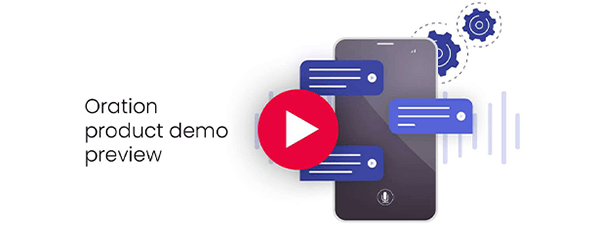Here’s the scenario. You phone up to a customer service help desk and are greeted by an automatic “How can I help you today?” message. You state your caller intent and the system states “before I transfer you, I’ll just check some security details”. It then lists a pre-determined set of questions to confirm that your identity is in fact a match to the customer record on file. You’ve just experienced artificial intelligence (AI) voice and speech recognition.
In this blog, we discuss what AI voice biometrics and speech recognition is, how they work and how to implement the function in your contact centre environment.
What is AI voice biometrics versus AI speech recognition?
The global voice and speech recognition market was valued at $22.78 billion in 2021 and is expected to grow at a compound annual growth rate (CAGR) of 15.3% from 2022 to 20301. This growth is largely attributed to the use of voice biometrics to authenticate users for security purposes in hardware and software advancements.
To determine the difference between speech recognition and voice biometrics think of it this way:
- Speech recognition interprets the words spoken
- Voice biometrics interprets the vocal characteristics; verifies the identity of the speaker.
Artificial intelligence comes in when the interpretation is completed by an AI-powered system. Frequently, these ‘voice assistants’ incorporate both speech recognition and voice biometrics into one function to recognise, interpret and action spoken commands without the need for human interference.
What is an example of speech recognition?
Popular examples of AI speech recognition technology include Apple’s Siri, Amazon’s Alexa, Google Assistant, Microsoft’s Cortana and Convai’s Oration. When you call a contact centre, you may have heard a voice assistant say something along the lines of “in just a few words, how may I direct your call?". This is AI speech recognition at work.
What are the benefits of automated customer verification?
Automated verification can be performed in a variety of ways, the most frequent is to request the caller to provide an ID number and a PIN. As consumers need to remember an ever increasing array of identifiers for the organisations they deal with, they frequently forget them, meaning that the job of authenticating the caller falls to the agent.
In a contact centre, customer voice identification can save valuable time by performing the verification of callers before they are transferred to a human agent. Along with using one or more typical verification questions (speech recognition), contact centre platforms have capabilities to integrate voice biometric verification for added security and improved caller experience.
Natural language solutions are now able to replicate the process that an agent goes through verifying a caller by asking a series of knowledge questions such as phone number, name, date of birth and address. This opens up the opportunity for downstream automation of more calls than traditional ID number and PIN-based solutions, as well as reduces AHT for those calls that go through to the contact centre.
How does voice biometrics work?
Voice biometrics enables an alternative form of automated customer verification which results in higher security and greater convenience. Voice biometrics captures speech snippets or samples and creates an enrolment template, known as a voiceprint, using that snippet, to then compare it to future samples.
Think of it as creating a voice blueprint, a ‘voiceprint’, like a fingerprint, but for your specific, individual vocal characteristics. The next time you call, this voice blueprint is used to identify whether or not your voice matches the voiceprint on file. It can then be used to flag your verification status to the contact centre agent. Customer voice identification technology can incorporate voice biometrics to further create a secure verification process for each customer as they call into a contact centre.
Customer voice identification can validate a caller based on them saying something as simple as their identity number or phone number, removing the need to ask them several questions.
How does AI voice biometrics work?
Let’s stick with the example of AI voice biometrics within a contact centre environment and one of the ways this identification process could work.
- A caller phones a contact centre.
- The contact centres' AI-powered call software answers and looks them up using their mobile number or identification number to see if they exist.
- If the calling line identification (CLI), or the number they are calling from is registered in the system as having an active voice biometrics enrolment, the system will then ask the caller to speak their identity token (their mobile number or another pre-determined token) and assess whether it is a match in the system.
- If the calling line identification (CLI), or the number they are calling from is not registered in the system as having an active voice biometrics enrolment, the system can instead request a series of knowledge tokens such as name, date of birth and address to verify the caller.
- Depending on the outcome of either the voice biometrics or knowledge tokens answers, the system can mark the caller as ‘verified’ or ‘not verified’ to let the contact centre agent know they have been screened.
During this process, if the caller is not already enrolled for voice biometrics, the AI-powered voice assistant can ask if they’d like to be enrolled for future calls to identify them quickly; the process of which can be as simple as asking them to say their mobile number three times to generate the ‘voiceprint’ we mentioned earlier.
How to implement customer voice identification in your contact centre
This is where interactive voice response (IVR) and natural language processing technology (NLP) come into play. We aren’t talking about the traditional IVR system that requires callers to select from fixed push button menus which restrict the customer's options. We are referring to conversational AI programs that incorporate intuitive and dynamic call flows to accurately identify caller intent from natural language responses.
Implementing this function into your contact centre may be as easy as sourcing a cloud-based plug-in that can act as an add-on to your current contact centre program. Or, you may want to completely overhaul your IVR system and implement a more intuitive platform that has customer voice identification features included.
Oration: a cloud-based contact centre plug-in using AI voice identification
Oration's Identify feature enables automated customer verification through the use of knowledge-based tokens as well as through voice biometrics. The customer experience for verification and enrolment can be easily configured, dramatically reducing the time to market for your automated customer verification solution.
Learn how to deploy customer identification software quickly and efficiently with Convai’s Oration.
Reference
1. https://www.grandviewresearch.com/industry-analysis/voice-recognition-market







